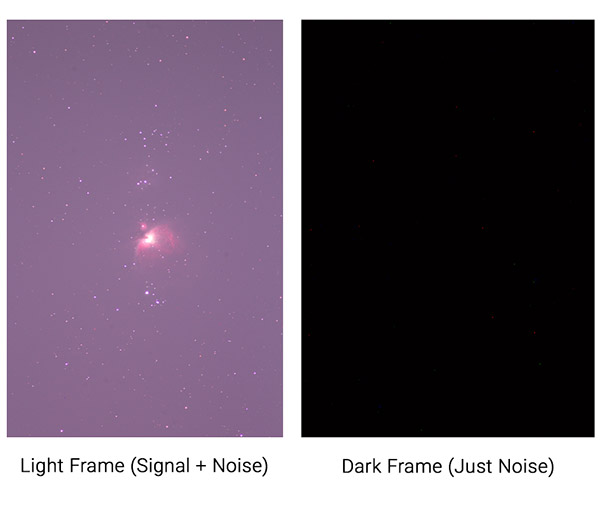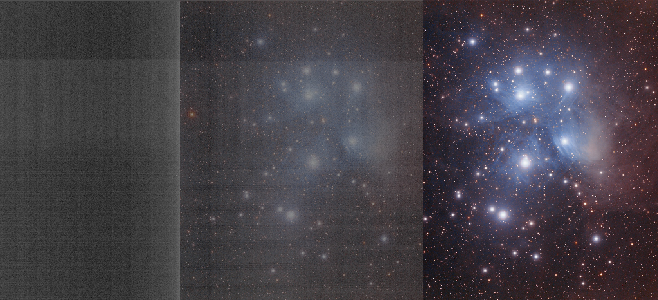In other words if you take several 3-minute exposures on your target youll want to calibrate them using a 3-minute master dark frame which youll subtract from the image. - posted in Beginning Deep Sky Imaging.

Re Astrophoto Post Processing Challenge Dark Frames And Noise Astrophotography Talk Forum Forum Digital Photography Review
The formula for opacity is 1000 pow2 layer_count 1 which if my maths doesnt suck should mean you end up with an average image at the end.

. The uneven field illumination and vignetting in my deep sky images were a real pain to correct in post-processing. Therefore the number of dark frames should also be high in order to compensate for this. If you take 200 dark frames the resulting noise is root 2 141x higher than just the stack of 200 lights ignoring pattern noise.
Only you will now need to match the exposure time the ISOgain value and the temperature of your flat frames. Just aim to use at least 15 as a minimum. The noise at the low end will be dominated by the noise in the 20 dark frames.
Dark frames primarily are used to subtract out thermal noise accumulation during long-exposure imaging sessions. Modern digital cameras circa post 2008 have on-sensor dark current suppression. A side note about hot pixels.
To get the most out of your table aim for at least 15. Weve seen this come up numerous times in comments and descriptions of images and in replies so we. If the camera is cooled then capturing the dark frames around the same temperature as the light frames will help reduce background noise in the stacked image.
The I have described for taking flats on this page is most useful for those shooting with a DSLR camera such as the Canon Rebel T3i I currently own. A more realistic rule of thumbs particularly for taking darks in the field is. To fix this dark frames need to be captured for the same length time as the main images.
Aim to capture 16-30 dark frames for conversion into a single master frame to average out the noise artefacts and increase the signal to noise ratio. Some photographers prefer way more up to 50 dark frames on a photograph but I believe they are utilizing files from a previous dark frame library. Stack of 32 light frames no calibration This is the reason why you should use as many darkbiasflat frames as possible.
Hi few nights ago I took 12 light frames of 5 min. Download your dark frames from a camera in exactly the same way as your image frames so in addition to holding a. There are no hard and fast rules on the number to take the only rule is you there is no such thing as too many.
I aim for 20 40 depending on exposure length of light frames. On the practical side 20 frames is a minimum if you want to not add too much noise and 50 to 100 will give you really nice and almost noise free masters. Many Budding Astrophotographers are often confused on exactly what Calibration frames are and if they even need to use them since they do take quite a bit of effort to acquire.
This ensures that the dark frame doesnt add any unwanted noise of its own to your images. Its a good idea if you have the time and can take 20 dark frames. How Many Dark Frames Astrophotography.
Like many aspects of deep-sky astrophotography your method of taking flat frames will vary depending on the equipment you use. Equally vital a bit more tricky to get right but a whole lot quicker than taking Dark FramesAnd whilst youre taking them you may as well do Dark Flat Frames too. If you have the time and to take 20 dark frames its a good idea.
I first take all the dark frames and layer them 1 on top of the other but reducing the opacity over time so that they all end up with an even value to give an average dark frame. With median stacking that should happen very quickly and its hard to see much benefit in going beyond say 9 darks maybe 15. If youre capturing 60-second exposures you need 60-second darks.
Flat frames are used to even out uneven illumination and certain other cosmetic defects. This images had 55 Light Frames at 300 seconds 20 Dark Frames 40 Flat and Dark Flat Frames and 100 Bias Frames. Calibration frames are an important part of the astrophotography process and if you get in any way serious about it they are essential.
So I did it a second time using all of the same calibrations I would normally use for a real observing run. Ideally the more calibration frames you take the better. Now I know that flat frames are as important as taking dark frames.
Like many aspects of deep sky astrophotography your method of taking flat frames will vary depending on the equipment you use. Take 20 darks at the end of capture and create a master dark with DSS can i do that btw just create a. Then I took 3 dark frames which is 15 min of exposure and thought Id be fine.
But unfortunately I had this donut-like patterns while processing which occurs due to lack of dark frames. With median stacking you may as well shoot an odd number of frames as at least youll get an actual pixel value returned though in reality it makes very little perhaps no difference. The DeepSkyStacker help sections states that using a minimum of 20 frames is ideal and using 50 100 will create nearly noise-free master dark frames.
Take a dark frame every 20 lights and use that to subtract from the previous 20 lights or -10 10 doesnt matter much probably this is fine-ish since im only missing one frame which ill interpolate for the timelapse though not ideal. Thats an hour of exposure. For an imaging project Ive had good results with 10 to 15 dark frames.
A dark frame is like a bias frame in that its an image taken with no light falling on the image sensor but dark frames need to be the same length as your light frames. Due to the high ISO number used for untracked astrophotography the darkframe noise is usually high. Today you can capture 15 dark frames for each project with any camera.
Last Updated on February 18 2022 by Practical Astrophotography Staff. 20 darks each at corresponding time and temp for data frames dark frames and flat frames 30 Bias frames and 20 flat frames at around 23000 max counts for eachthe chip is a KAF 6303 in an SBIG STXL camera To take flat frames point your scope at the zenith or your. The images shown here were obtained with a number of 40-60 dark frames obtained at the end of each shooting session.
If youve read my post on Dark Frames youll remember I said they were one of two key calibration framesWell Flat Frames are the other. If your astrophotography photograph incorporates data from multiple nights youll need to match the darks for each set. A Brief Guide To Calibration Frames Bias Dark Flats And Dark Flats Practical Astrophotography Magazine In other words if you take several 3-minute exposures on your target youll want to calibrate them using a 3-minute master dark.
How Many Should I Take Of Each. How many dark frames do you take. If you take 200 light frames and 20 dark frames.

How To Take Dark Frames For Astrophotography Best Practices

Guide To Calibration Frames Lights Darks Flats Dark Flats And Bias

Dark Frames And Bias Frames Demystified Sky Telescope Sky Telescope

A Brief Guide To Calibration Frames Bias Dark Flats And Dark Flats Practical Astrophotography Magazine

How To Take Dark Frames For Astrophotography Best Practices

How To Take Dark Frames For Astrophotography Best Practices

Comparison Of An Image With And Without Dark And Bias Frames R Astrophotography

Dark Frames In Astrophotography What They Are How To Use Them Bbc Sky At Night Magazine
0 comments
Post a Comment